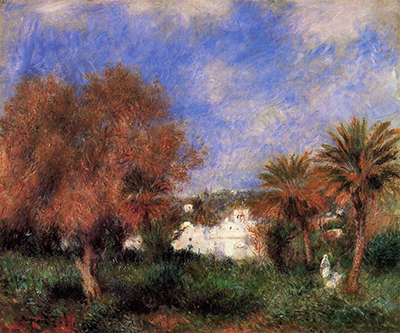The Garden of Essai in Algiers was painted as a result of a tour that Renoir took of Italy and Algiers in the early 1880s - this tour was to change his life forever
It focused his mind as an artist and inspired him to reject what he came to see as the 'ephemerality' of the Impressionist movement which he had hitherto been following relatively closely. The Garden of Essai is a beautiful botanical garden that covers 58 hectares.
It can still be visited today, so modern day visitors can stroll through the pathways that Renoir once strolled. Renoir's eye as an artist was always drawn to lush natural beauty, and there is an abundance of this in the Garden of Essai, as he manages to convey in his painting on the subject.
The Garden of Essai in Algiers is a painting that documents and also helped to instigate the transformative experience that Renoir had during his time in northern Africa and Italy.
The Garden of Essai in Algiers depicts the garden and some of its buildings in softened, dreamlike tones. There is definitely a sense of a hazy day under hot sun, and a highly emotional feel that still bears definite traces of impressionism.
The trees and shrubs on either side of the painting seem to be bending aside of their own accord to make way for the viewer's eye to sweep up to the white building in the centre of the piece - this building is definitely its focal point, though wherever the eye looks there is a delightfully harmonious concatenation of colour to rest upon.
The Garden of Essai in Algiers is not the only painting that Renoir created around the theme of this garden. In another work, for example, he focuses on the shape of the palm trees that were to be found in the garden, painting them in such a way that they looked similar to fireworks against the deep blue sky. This latter mentioned painting is sometimes just called 'Garden', but it is unmistakably a depiction of Essai.
Gardens have inspired artists for centuries. Recently Paul Klee captured Föhn Wind in Franz Marc's Garden which stands out as one of his finest paintings, along with the likes of Castle and Sun, Twittering Machine and Angelus Novus.
Like the painting called The Garden of Essai in Algiers, The Garden plunges the viewer right into the centre of the garden - they are able to experience almost what it is like to be there. At the same time, The Garden pays attention to light and shadow in ways that The Garden of Essai in Algiers does not - the crisp shadows cast by the leaves of the trees are depicted in a realistic manner. All in all, it can be argued that Renoir's time at Essai helped to cement his turn towards a more realistic and (as it is often described) a more 'disciplined' way of painting landscapes.
His time in Italy, moreover, would help to discipline his depiction of the human form as he studied classical sculptures during his time in Italy. Renoir would, throughout the 1880s and beyond - up to his death in 1919 - meld these two disciplines by painting human figures set in vividly realistic landscapes (Pieter Bruegel the Elder famously did the same in classic works such as Hunters in the Snow, Netherlandish Proverbs and Tower of Babel). See also Bosch's Garden of Earthly Delights.




